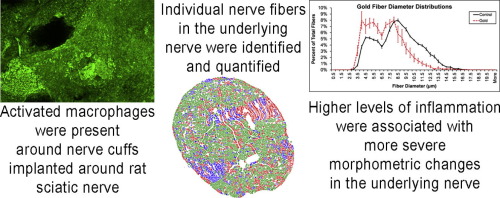Acta Biomaterialia ( IF 9.4 ) Pub Date : 2017-12-06 , DOI: 10.1016/j.actbio.2017.11.059 Michael B. Christensen , Patrick A. Tresco

|
Nerve cuffs have been used to anchor and protect penetrating electrodes in peripheral nerves and have been used as non-penetrating electrodes for neural recording and nerve stimulation. The material of choice for such applications is silicone, an inert synthetic biomaterial which elicits a minimal chronic foreign body response (FBR). While histological studies of solid silicone cuffs are available, to the best of our knowledge a comparison to other cuff designs is not well documented. Here, we describe the FBR and morphological changes that accompany nerve cuff implantation in the rat sciatic nerve by comparing a metallic mesh with and without a parylene coating to one made of silicone. Two months after implantation, we observed that such implants, irrespective of the cuff type, were associated with a persistent inflammatory response consisting of activated macrophages attached to the implant surfaces, which extended into the endoneurial space of the encapsulated nerve. We also observed foreign body giant cells in the epineurial space that were more prevalent in the mesh cohorts. The mesh cuff groups showed significant changes in several morphometric parameters that were not seen in the silicon group including reductions in nerve fiber packing density and a greater reduction of large diameter fibers. High magnification microscopy also showed greater evidence of foamy macrophages in the endoneurial space of the mesh implanted cohorts. Although the precise mechanisms are unknown, the results showed that mesh style nerve cuffs show a greater inflammatory response and had greater reductions in morphometric changes in the underlying nerve compared to silicone in the absence of a penetrating injury.
Statement of Significance
While traditional silicone cuffs have been in use for decades, the inflammatory and morphometric effects of these cuffs on the underlying nerve have not been deeply studied. Further, manipulation of the foreign body response to nerve cuffs by using various materials and/or designs has not been well reported. Therefore, we report the inflammatory response around nerve cuffs of various materials and designs, as well as report morphometric parameters of the underlying nerve. These data provide important information regarding the potential for quantitative morphometric changes associated with the use of nerve cuffs, and, importantly, suggests that these changes are associated with the degree of inflammation associated with the cuff.
中文翻译:

网状式周围神经袖套的异物反应和形态变化
神经袖套已被用于固定和保护周围神经中的穿透电极,并已被用作神经记录和神经刺激的非穿透电极。用于此类应用的材料选择是有机硅,这是一种惰性合成生物材料,可引起最小的慢性异物反应(FBR)。尽管可以对固体硅胶套囊进行组织学研究,但据我们所知,与其他套囊设计的比较尚无充分文献记载。在这里,我们通过将带有和不带有聚对二甲苯涂层的金属网与由硅树脂制成的金属网进行比较,来描述随神经袖套植入大鼠坐骨神经中的FBR和形态变化。植入后两个月,我们观察到这种植入物,无论袖带类型如何,它们与持续的炎症反应有关,该炎症反应由附着在植入物表面的活化巨噬细胞组成,该巨噬细胞延伸到包膜神经的神经内膜间隙。我们还观察到了在网膜队列中更普遍的是在肾上腺空间的异物巨细胞。网状袖带组在几个形态学参数上显示出显着变化,这在硅组中是看不到的,包括神经纤维堆积密度的降低和大直径纤维的更大降低。高倍显微镜还显示了植入的网状组织的神经内膜间隙中泡沫巨噬细胞的更多证据。尽管确切的机制尚不清楚,
重要声明
尽管传统的硅胶套囊已经使用了数十年,但这些套囊对基础神经的炎症和形态计量作用尚未得到深入研究。此外,尚未充分报道通过使用各种材料和/或设计来操纵异物对神经袖套的反应。因此,我们报告了各种材料和设计的神经套周围的炎症反应,并报告了潜在神经的形态学参数。这些数据提供了有关与使用神经袖套有关的定量形态变化潜力的重要信息,并且重要的是,这些变化与与袖套有关的炎症程度有关。











































 京公网安备 11010802027423号
京公网安备 11010802027423号